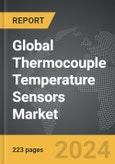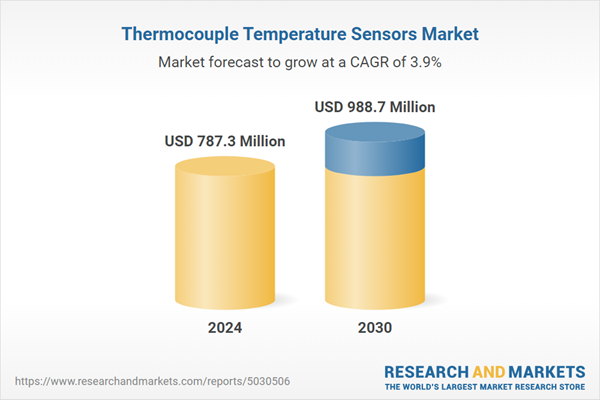The global market for Thermocouple Temperature Sensors was valued at US$787.3 Million in 2024 and is projected to reach US$988.7 Million by 2030, growing at a CAGR of 3.9% from 2024 to 2030. This comprehensive report provides an in-depth analysis of market trends, drivers, and forecasts, helping you make informed business decisions. The report includes the most recent global tariff developments and how they impact the Thermocouple Temperature Sensors market.
Segments: Application (Food & Beverage, Power Generation, Automotive, Petrochemicals & Chemicals, Oil & Gas, Metals & Mining, Other Applications).
Geographic Regions/Countries: World; United States; Canada; Japan; China; Europe (France; Germany; Italy; United Kingdom; Spain; Russia; and Rest of Europe); Asia-Pacific (Australia; India; South Korea; and Rest of Asia-Pacific); Latin America (Argentina; Brazil; Mexico; and Rest of Latin America); Middle East (Iran; Israel; Saudi Arabia; United Arab Emirates; and Rest of Middle East); and Africa.
The analysts continuously track trade developments worldwide, drawing insights from leading global economists and over 200 industry and policy institutions, including think tanks, trade organizations, and national economic advisory bodies. This intelligence is integrated into forecasting models to provide timely, data-driven analysis of emerging risks and opportunities.
Global Thermocouple Temperature Sensors Market - Key Trends and Drivers Summarized
Why Are Thermocouple Temperature Sensors Crucial Across Industries?
Thermocouple temperature sensors, which measure temperature based on voltage generated by the junction of two dissimilar metals, are widely used across industries due to their robustness, cost-effectiveness, and broad temperature range capabilities. Industries such as aerospace, automotive, and industrial manufacturing rely on thermocouples for monitoring and controlling high-temperature processes. In the energy sector, thermocouples are indispensable in power generation, especially in monitoring turbines and boilers. Additionally, their high-temperature tolerance and durability make them ideal for applications in chemical processing and metal refining, where extreme heat levels are common. As industrial automation advances, the demand for reliable and accurate temperature sensing continues to grow, placing thermocouples at the forefront of temperature monitoring solutions.How Are Market Segments Influencing the Thermocouple Market?
Type-wise, thermocouples are categorized into Type K, J, T, E, N, and others, with Type K thermocouples being the most widely used due to their versatility and wide temperature range. Application-wise, thermocouples are critical in industries where temperature control is essential for operational safety and efficiency. End-use industries span across sectors such as power, automotive, chemicals, mining, healthcare, industrial automation, oil and gas, and food and beverage, where thermocouples play a vital role in process monitoring. As each segment demands different performance specifications, the market continues to grow by catering to a diverse array of industrial needs.What Innovations Are Shaping the Future of Thermocouple Sensors?
Innovations in thermocouple technology are enhancing accuracy, response times, and integration with modern digital control systems. The integration of thermocouples with wireless communication technologies is streamlining data acquisition processes in industrial settings. This allows for real-time temperature monitoring in remote or hazardous environments, improving overall efficiency and safety. Additionally, advancements in materials science have resulted in thermocouples with improved corrosion resistance, enabling their use in more aggressive environments, such as chemical manufacturing and petrochemical refining. Moreover, the increasing focus on predictive maintenance has led to the development of smart thermocouples that can detect potential system failures by providing early warning signals based on temperature deviations.What Factors Are Driving Growth in the Thermocouple Temperature Sensors Market?
The growth in the thermocouple temperature sensors market is driven by several factors, including the rising demand for temperature control in industrial automation, the increasing application of thermocouples in electric vehicles (EVs), and their expanding use in high-temperature industrial processes. As industries adopt more energy-efficient and sustainable practices, the need for precise temperature control in power generation, particularly in renewable energy systems like solar and wind, is fueling demand for thermocouples. Regulatory requirements for safety and environmental standards are also pushing industries such as oil and gas to enhance process monitoring, further driving the market. The growing integration of thermocouples with IoT and wireless systems is another critical driver, enabling real-time data analytics and predictive maintenance in industries like manufacturing and aerospace.Report Scope
The report analyzes the Thermocouple Temperature Sensors market, presented in terms of units. The analysis covers the key segments and geographic regions outlined below.Segments: Application (Food & Beverage, Power Generation, Automotive, Petrochemicals & Chemicals, Oil & Gas, Metals & Mining, Other Applications).
Geographic Regions/Countries: World; United States; Canada; Japan; China; Europe (France; Germany; Italy; United Kingdom; Spain; Russia; and Rest of Europe); Asia-Pacific (Australia; India; South Korea; and Rest of Asia-Pacific); Latin America (Argentina; Brazil; Mexico; and Rest of Latin America); Middle East (Iran; Israel; Saudi Arabia; United Arab Emirates; and Rest of Middle East); and Africa.
Key Insights:
- Market Growth: Understand the significant growth trajectory of the Food & Beverage segment, which is expected to reach US$237.7 Million by 2030 with a CAGR of a 3.7%. The Power Generation segment is also set to grow at 3.1% CAGR over the analysis period.
- Regional Analysis: Gain insights into the U.S. market, valued at $210.9 Million in 2024, and China, forecasted to grow at an impressive 6.1% CAGR to reach $201.0 Million by 2030. Discover growth trends in other key regions, including Japan, Canada, Germany, and the Asia-Pacific.
Why You Should Buy This Report:
- Detailed Market Analysis: Access a thorough analysis of the Global Thermocouple Temperature Sensors Market, covering all major geographic regions and market segments.
- Competitive Insights: Get an overview of the competitive landscape, including the market presence of major players across different geographies.
- Future Trends and Drivers: Understand the key trends and drivers shaping the future of the Global Thermocouple Temperature Sensors Market.
- Actionable Insights: Benefit from actionable insights that can help you identify new revenue opportunities and make strategic business decisions.
Key Questions Answered:
- How is the Global Thermocouple Temperature Sensors Market expected to evolve by 2030?
- What are the main drivers and restraints affecting the market?
- Which market segments will grow the most over the forecast period?
- How will market shares for different regions and segments change by 2030?
- Who are the leading players in the market, and what are their prospects?
Report Features:
- Comprehensive Market Data: Independent analysis of annual sales and market forecasts in US$ Million from 2024 to 2030.
- In-Depth Regional Analysis: Detailed insights into key markets, including the U.S., China, Japan, Canada, Europe, Asia-Pacific, Latin America, Middle East, and Africa.
- Company Profiles: Coverage of players such as ABB Ltd., Analog Devices, Inc., Emersion Electric Co., General Electric Company, Honeywell International, Inc. and more.
- Complimentary Updates: Receive free report updates for one year to keep you informed of the latest market developments.
Some of the 41 companies featured in this Thermocouple Temperature Sensors market report include:
- ABB Ltd.
- Analog Devices, Inc.
- Emersion Electric Co.
- General Electric Company
- Honeywell International, Inc.
- Kongsberg Gruppen ASA
- Maxim Integrated Products, Inc.
- Microchip Technology, Inc.
- Mouser Electronics, Inc.
- NXP Semiconductors NV
- Panasonic Corporation
- Siemens AG
- STMicroelectronics NV
- Texas Instruments, Inc.
Tariff Impact Analysis: Key Insights for 2025
Global tariff negotiations across 180+ countries are reshaping supply chains, costs, and competitiveness. This report reflects the latest developments as of April 2025 and incorporates forward-looking insights into the market outlook.The analysts continuously track trade developments worldwide, drawing insights from leading global economists and over 200 industry and policy institutions, including think tanks, trade organizations, and national economic advisory bodies. This intelligence is integrated into forecasting models to provide timely, data-driven analysis of emerging risks and opportunities.
What’s Included in This Edition:
- Tariff-adjusted market forecasts by region and segment
- Analysis of cost and supply chain implications by sourcing and trade exposure
- Strategic insights into geographic shifts
Buyers receive a free July 2025 update with:
- Finalized tariff impacts and new trade agreement effects
- Updated projections reflecting global sourcing and cost shifts
- Expanded country-specific coverage across the industry
Table of Contents
I. METHODOLOGYII. EXECUTIVE SUMMARY2. FOCUS ON SELECT PLAYERSIII. MARKET ANALYSISSOUTH KOREAREST OF ASIA-PACIFICARGENTINABRAZILMEXICOREST OF LATIN AMERICAIRANISRAELSAUDI ARABIAUNITED ARAB EMIRATESREST OF MIDDLE EASTIV. COMPETITION
1. MARKET OVERVIEW
3. MARKET TRENDS & DRIVERS
4. GLOBAL MARKET PERSPECTIVE
UNITED STATES
CANADA
JAPAN
CHINA
EUROPE
FRANCE
GERMANY
ITALY
UNITED KINGDOM
SPAIN
RUSSIA
REST OF EUROPE
ASIA-PACIFIC
AUSTRALIA
INDIA
LATIN AMERICA
MIDDLE EAST
AFRICA
Companies Mentioned (Partial List)
A selection of companies mentioned in this report includes, but is not limited to:
- ABB Ltd.
- Analog Devices, Inc.
- Emersion Electric Co.
- General Electric Company
- Honeywell International, Inc.
- Kongsberg Gruppen ASA
- Maxim Integrated Products, Inc.
- Microchip Technology, Inc.
- Mouser Electronics, Inc.
- NXP Semiconductors NV
- Panasonic Corporation
- Siemens AG
- STMicroelectronics NV
- Texas Instruments, Inc.
Table Information
| Report Attribute | Details |
|---|---|
| No. of Pages | 223 |
| Published | April 2025 |
| Forecast Period | 2024 - 2030 |
| Estimated Market Value ( USD | $ 787.3 Million |
| Forecasted Market Value ( USD | $ 988.7 Million |
| Compound Annual Growth Rate | 3.9% |
| Regions Covered | Global |









